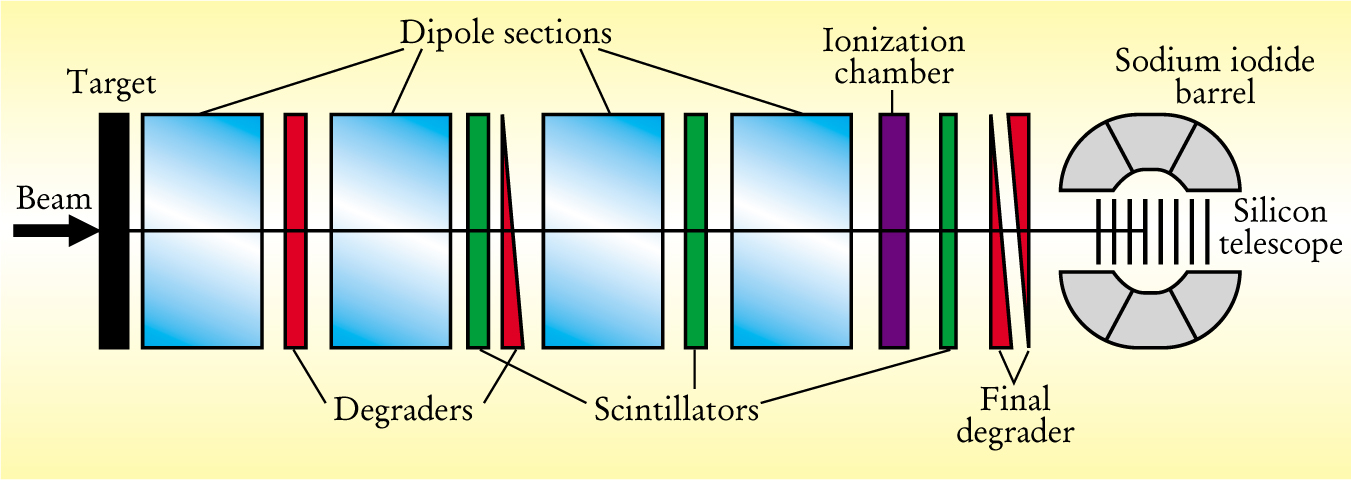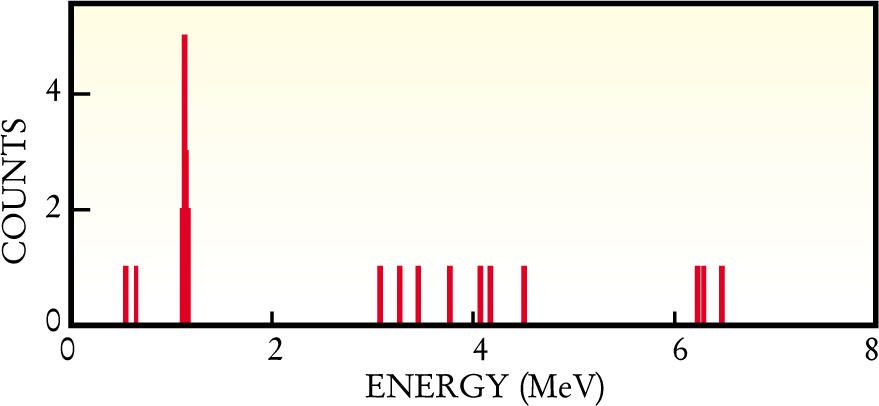Evidence Found for a New Type of Radioactivity: Two-Proton Emission
DOI: 10.1063/1.1522200
The interplay between the nuclear forces and the electromagnetic force determines whether a given combination of protons and neutrons can stay together long enough to be called a nucleus. Even then, some nuclei are sufficiently unstable that, sooner or later, they undergo fission or decay. It stands to reason that a proton-rich nucleus might strive to shed a few protons. Indeed, back in 1960, Vitalii Goldanskii predicted that proton-rich nuclei having even values of atomic number Z could decay by emitting two protons. 1 Iron-45 was among the rare candidates in which Goldanskii predicted one might see such two-proton decay. Iron-45, having 11 fewer neutrons than the most common isotope of iron, has only recently been produced in heavy-ion accelerators. Now, research teams at the Laboratory for Heavy-Ion Research (GSI) in Darmstadt, Germany, and at GANIL, a national heavy-ion accelerator in Caen, France, have independently formed 45Fe and found evidence for two-proton (2p) decay. 2,3
The two decay protons can serve as a probe of nuclear structure. Of particular interest is how the protons are paired within the nucleus, especially in such a proton-rich nucleus as 45Fe, which is itself nearly unbound. If the protons are strongly correlated with one another, they should emerge as a single nucleus of helium-2 before Coulomb forces push them apart. If the protons are completely independent of one another, the 45Fe nucleus would undergo a three-body decay. According to Bertram Blank of the Center for Nuclear Energy Studies in Bordeaux-Gradignan, France, “we know that pairing exists, but there are very few direct routes to access and study it.” Two-proton decay is thus seen as a valuable tool for gaining insight into nuclear structure. (Blank headed the GANIL team; Marek Pfützner of the University of Warsaw led the GSI team.)
Unfortunately, the recent experiments can’t determine the extent of proton–proton correlation because the experimental setups don’t allow determination of the angles and energies of the individual protons. Such experiments are several years off, but efforts in that direction have certainly been boosted by the recently sighted 2p decays.
Other proton decays
Goldanskii also predicted that proton-rich nuclei with odd Z could decay by emission of just one proton. Since 1981, single-proton radioactivity has been seen in the ground states of proton-rich nuclei with odd values of Z ranging from 51 to 83. Those decays are to be distinguished from the more common case of beta-delayed proton emission, in which the parent nucleus first undergoes beta decay, with the proton subsequently coming from an excited state of the daughter. True one-proton decay requires the end state of proton emission to be lower in energy than the parent nucleus and for that end state to have compatible quantum properties. The boundary conditions on two-proton decay are even more stringent.
Several previous experiments have found some evidence for 2p decay in beryllium-6 and oxygen-12. 4,5 But those nuclei are so short-lived, with half-lives on the order of 10−20 s, that it’s virtually impossible to know whether the protons come out at the same time. The decay may proceed through an intermediate level, with the protons emitted sequentially: Although single-proton decay is energetically forbidden, the ground-state energy is sufficiently broad for either 6Be or 12O (because of the short lifetimes) that its tail might overlap with a normally inaccessible intermediate level.
In another experiment, done in 2000 at Oak Ridge National Laboratory’s Holifield Radioactive Ion Beam Facility, researchers reported 2p decay from an excited state (as opposed to the ground state) of neon-18, whose lifetime is quite short (around 10−15 s). 6 No intermediate state was available for a sequential decay, although the decay conceivably might have proceeded through the tail of a very broad, higher-lying excited state. Oak Ridge’s Alfredo Galindo-Uribarri said that he and his colleagues are now setting up an experiment with much larger solid angle coverage of the emerging protons to gain insight into the decay mechanism.
The recent experiments on 45Fe have elicited particular excitement because the decay occurs from a ground state that lasts for several milliseconds. “For that reason, one could call the process ‘radioactivity,’ while the phenomenon seen in neon-18 is a simultaneous two-proton emission from an excited state,” said theorist Witek Nazarewicz of the University of Tennessee, Knoxville.
Serendipity
The observation of the 2p decay required not only technical skill but also some luck. The experimenters at GSI and GANIL first had to form the unstable nucleus; they were aided in that task by the techniques of projectile fragmentation, separation, and identification that have been honed over the past few years. Next, they had to form a nucleus in which the 2p decay time was longer than the flight time of the parent nucleus through the separator (about 1 ms) and yet shorter than the competing beta decay (several milliseconds). Fortunately, the lifetime of 45Fe turned out to be a few milliseconds and appeared to be dominated by the 2p emission.
Both research groups began with an energetic beam of nickel-58 ions striking a fixed target; the target was made of beryllium in the GSI experiment and nickel at GANIL. The accelerators at the two facilities differ in beam energy and intensity: At GSI, a higher beam energy (600 MeV per nucleon versus 75 MeV/nucleon at GANIL), compensates for a factor-of-100 lower intensity.
In both experiments, the impact on the target breaks up the heavy ion, producing a variety of product nuclei; a tiny fraction are of the desired 45Fe isotope. As illustrated in figure 1 for the GSI experiment, the fragments travel through a separator consisting largely of magnets that bend the ions and of degraders that help slow them. The mass and charge of an ion are determined by measurement of the ion’s time-of-flight and energy loss, and knowledge of the separator magnetic fields. Such information rather clearly determines which nuclei are 45Fe. At the end of the separator, the slowed ions become implanted in one of a stack of silicon detectors. The electronics for those detectors have to be capable of measuring both the large energy (on the order of 1 GeV) deposited by the nucleus when it is stopped and the smaller energy (around 1 MeV) subsequently deposited by the decay protons. The detectors are equipped with both high- and low-gain preamplifiers that render them sensitive to the disparate energy scales.

Experimental setup to look for two-proton decays of iron-45 at the Laboratory for Heavy-Ion Research (GSI) in Darmstadt, Germany. The nickel-58 ions in the beam are fragmented by impact with the beryllium target. Ions of interest are selected by the fragment separator, which consists primarily of dipole magnet sections (blue). Measurements by the plastic scintillators (green) and ionization chamber (purple) help identify each ion. Degraders (red) slow the ions and help reduce contamination. Ions of 45Fe come to rest in one of the silicon detectors that compose the silicon telescope. The detector measures the total energy of the 45Fe decay products.
(Adapted from ref. 2.)

The silicon detectors are surrounded by sodium iodide crystals, which record gamma rays from the annihilation of the positron emitted during beta decay. For evidence of 2p decay, the experimenters took only those decays that were not associated with the emission of gamma or beta radiation. The GANIL team found 12 2p-decay candidates, and the GSI group identified four.
In both experiments, a plot of the total energy deposited in the silicon detector by the decay had a narrow peak around 1 MeV, a value that had been predicted for the 2p decay by several theoretical models. 7,8 Figure 2 shows, for example, the spectrum measured in the GANIL experiment.

Decay-energy spectrum for the two protons emitted by iron-45, as measured in an experiment at the GANIL accelerator in Caen, France. A peak is seen near 1 MeV, the energy expected to be emitted in two-proton decays. After eliminating protons that emerge more than 15 ms after 45Fe is implanted in the detector, the researchers find the total energy of the two protons to be 1.06±0.04 MeV.
(Figure courtesy of Bertram Blank, Center for Nuclear Studies.)

The two experiments yielded consistent values for the 2p decay time: (4.7
Margareta Hellström of GSI agreed that more detailed model calculations are needed before quantitative comparisons can be made with experiment, but she noted that “we already have a reasonably good qualitative understanding of what is going on in iron-45.”
Taking the next step
The central drawback of the current experiments is that they need a thick detector to stop the 45Fe ions, and the thick detector captures the decay protons. To look for correlations, one needs to follow the proton trajectories (angles and energies). Blank and members of his team at GANIL plan to replace the stack of silicon detectors with a gas cell to stop the 45Fe ions. The gas cell will form a time-projection chamber in which an electric field will move the charge cloud produced by the decay toward a two-dimensional detector. The new setup should determine the protons’ energies and angles. So far the researchers have built a prototype detector and hope to complete the full-scale one in a year or so.
The observation of proton pairs coming from the nucleus may have broad interest beyond nuclear physics, Nazarewicz said. There might be common threads, for example, between studies of paired protons within a nucleus and considerations of finite size effects on superconducting Cooper pairs of electrons in, say, aluminum grains. Indeed, the term “nuclear superconductivity” was introduced by David Pines at a conference in Rehovot, Israel more than 40 years ago to describe work he had done with Aage Bohr and Ben Mottelson; the trio showed that the thennew Bardeen-Cooper-Schrieffer theory of superconductivity could also be applied to explain pairing phenomena in nuclei. 10
References
1. V. Goldanskii, Nucl. Phys. 19, 482 (1960).https://doi.org/10.1016/0029-5582(60)90258-3
2. M. Pfützner, E. Badura, C. Bingham, B. Blank, M. Chartier, H. Geissel, J. Giovinazzo, L. V. Grigorenko, R. Grzywacz, M. Helström, Z. Janas, J. Kurcewicz, A. S. Lalleman, C. Mazzocchi, I. Mukha, G. Münzenberg, C. Plettner, E. Roeckl, K. P. Rykaczewski, K. Schimdt, R. S. Simon, M. Stanoiu, J.-C. Thomas, Eur. Phys. J. A14, 279 (2002).
3. J. Giovinazzo, B. Blank, M. Chartier, S. Czajkowski, A. Fleury, M. J. Lopez Jimenez, M. S. Pravikoff, J.-C. Thomas, F. de Oliveira Santos, M. Lewitowicz, V. Maslov, M. Stanoiu, R. Grzywacz, M. Pfützner, C. Borcea, B. A. Brown, to appear inPhys. Rev. Lett. (2002).
4. O. V. Bochkarev et al., Sov. J. Nucl. Phys. 55, 955 (1992).
5. R. A. Kryger et al., Phys. Rev. Lett. 74, 860 (1995).https://doi.org/10.1103/PhysRevLett.74.860
6. J. Gómez del Campo et al., Phys. Rev. Lett. 86, 43 (2000).https://doi.org/10.1103/PhysRevLett.86.43
7. B. A. Brown, Phys. Rev. C 43, R1513 (1991).https://doi.org/10.1103/PhysRevC.43.R1513
8. E. Ormand, Phys. Rev. C 53, 214 (1996);https://doi.org/10.1103/PhysRevC.53.214
B. J. Cole, Phys. Rev. C 54, 1240 (1996).https://doi.org/10.1103/PhysRevC.54.12409. L. V. Grigorenko et al., Phys. Rev. Lett. 85, 22 (2000);https://doi.org/10.1103/PhysRevLett.85.22
F. C. Barker, Phys. Rev. C 63, 047303 (2001).https://doi.org/10.1103/PhysRevC.63.04730310. D. Pines et al., Phys. Rev. 110, 936 (1958).https://doi.org/10.1103/PhysRev.110.936
